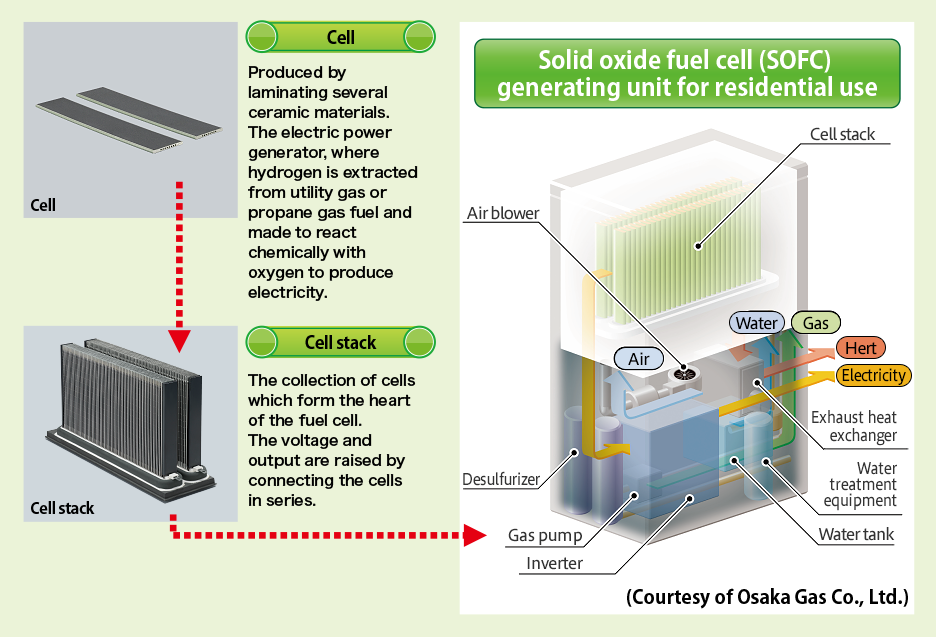Fine Ceramics, sometimes referred to as "advanced ceramics," are engineered materials that support the development of cutting-edge technology.
Fine Ceramics Contribute to a Cleaner Environment
Ideal for an Eco-Friendly Life with Higher Power Generation Efficiency
Employed in the core of the Solid Oxide Fuel Cell (SOFC) system for residential use
Solid oxide fuel cells for residential use are made up of two units: a generating unit to produce electricity and a hot-water supply unit which uses the heat produced when electricity is generated. They are highly energy efficient, produce an extremely low amount of nitrogen oxide (NOx) and sulfur oxide (SOx), and emit very little carbon dioxide (CO2), a leading cause of climate change. As an environmentally friendly system for the home, their use is expected to increase in the future.

The Solid Oxide Fuel Cell (SOFC) system for residential use mechanism
Understanding the Features of Fine Ceramics
Various types of fuel cells are made by using different materials for the cells at the heart of the system. Polymer electrolyte fuel cells (PEFC) using polymer electrolyte membranes are already available for residential use. However, one company has proceeded with the development of solid oxide fuel cells (SOFCs), which generate electricity even more efficiently than PEFCs. For the cell materials Kyocera uses Fine Ceramics, with their superior heat resistance and durability, and they have achieved the highest levels of generating efficiency in the world.*
* For residential fuel cells with output less than 1kW (As of February 24th, 2016 based on study by Osaka Gas Co., Ltd.)
Types of fuel cells for residential use
| Polymer electrolyte fuel cells (PEFCs) | Solid oxide fuel cells (SOFCs) | |
| Cell (electrolyte) | Polymer | Fine Ceramics |
| Operating temperature | Room temperature – 90℃ | 700℃ and above |
| Generating efficiency | 35 – 40% | 50% and above |
| Main uses | Cogeneration for residential use Automotive use |
Cogeneration for residential use Cogeneration for business use |
The term "Fine Ceramics" is interchangeable with "advanced ceramics," "technical ceramics" and "engineered ceramics." Use varies by region and industry.
If you want to use ceramics in business, click here.
Kyocera's Fine Ceramics products (All websites below open in a separate window.)
Product Category
 Semiconductor / LCD Processing Equipment
Semiconductor / LCD Processing Equipment
 Life / Culture / Industrial Machines
Life / Culture / Industrial Machines
 Wireless Communications
Wireless Communications
 Computer Peripherals
Computer Peripherals
 Environmental Preservation / Renewable Energy
Environmental Preservation / Renewable Energy
 Medical Equipment / Devices
Medical Equipment / Devices
 Single-Crystal Sapphire Products
Single-Crystal Sapphire Products
 Metallized / Vacuum Components
Metallized / Vacuum Components
 Electronics Industry
Electronics Industry
 Heaters
Heaters
 Piezoelectric Ceramics
Piezoelectric Ceramics
Search by Material
 Alumina
Alumina
 Silicon Nitride
Silicon Nitride
 Silicon Carbide
Silicon Carbide
 Sapphire
Sapphire
 Zirconia
Zirconia
 Cordierite
Cordierite
 Yttria
Yttria
 Aluminum Nitride
Aluminum Nitride
 Cermet
Cermet
 Mullite
Mullite
 Steatite
Steatite
 Forsterite
Forsterite
Search by Property/Characteristic


- Thermal Properties
- Coefficient of Thermal Expansion
- Thermal Conductivity
- Heat Shock Resistance

- Electrical Properties
- Insulation / Semiconductivity

- Chemical Properties
- Chemical Resistance






